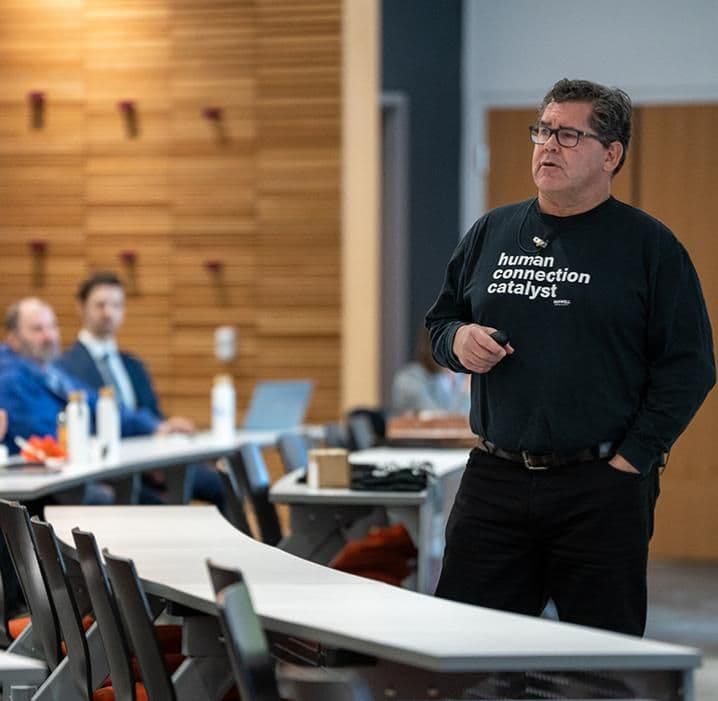Canada
Community guidelines
Communities thrive when everyone feels connected and supported. The guidelines below provide recommendations for communities and their leaders. By implementing these guidelines, we can reduce and prevent loneliness, social isolation and disconnection.
1 / 6
Promote awareness of the importance of social connection
All organizations play an important role in facilitating social interactions and creating norms that make social connections easier.
- Play an active role in promoting widespread awareness of the importance of social connection through health promotion, community dialogues, professional education programs, policy-making and other efforts.

2 / 6
Foster healthy social and emotional development
Strong emotional and social skills foster health and happiness. To achieve these skills, communities should facilitate and support individuals at all stages of life to refine their social skills and meet their varied social needs.
- Develop and implement age and community-appropriate social and emotional education activities, curriculum, resources, and other tailored supports that empower individuals and communities to connect.

Case studies
Vancouver, British Columbia, Canada
Building Community one Building at a Time: Hey Neighbour Collective's Multi-Unit Housing Programs
3 / 6
Make social connection a priority in policies and practices
Policies and practices across all layers of governance play an important role in shaping social wellbeing. Many policy areas that are not immediately relevant to social connection or health can have profound consequences on social and community wellbeing.
- Consider the social impacts of policy decisions and review existing policies, and integral collaboration between policy domains, to assess how they can foster or inhibit social connection.
- Invest in social programming and organizations that support social connection.

4 / 6
Design environments for connection and invest in social events, activities, and programs
Built, natural, and social environments play an important role in facilitating social interactions.
- Ensure that the built and natural environments are suitable for encouraging, facilitating, and sustaining social connections.
- Implement programming that maximizes social use of the built and natural environment thereby providing opportunities for social connection and interaction within and even across communities.

"When considering the umbrella term of social connection and its constituent components, there are perhaps no other factors that can have such a large impact on both length and quality of life—from the cradle to the grave. Yet, social connection is largely ignored as a health determinant because public and private stakeholders are not entirely sure how to act. "
“Many types of scientific evidence show that involvement in social relationships benefits health. The most striking evidence comes from prospective studies of mortality across industrialized nations. These studies consistently show that individuals with the lowest level of involvement in social relationships are more likely to die than those with greater involvement.”
5 / 6
Improve accessibility and inclusion for all people
While all human beings need social connection, people in every community can experience barriers to accessibility and inclusion. These barriers can create unique vulnerabilities to loneliness, isolation, and disconnection. Communities must work together to remove these barriers.
- Ensure that all spaces and activities are equitably accessible for all community members.
- Ensure that tailored activities and programs are available for people of different ages, abilities, socioeconomic classes, cultural backgrounds, language groups, and with different social and recreational interests.
- Actively seek to eliminate stigma, discrimination, and violence.
- Advance reconciliation, equity, diversity, and inclusion.

6 / 6
Measure and make progress towards improving social wellbeing
Achieving social wellbeing at the individual and population levels requires ongoing investments in monitoring and improving social connection.
- Allocate funding and resources for research and evaluation on social connectedness.
- Develop measurement frameworks for understanding community social wellbeing.
- Measure social wellbeing at a community-level and monitor progress towards improvements in social connection.
- Identify the best evidence-based strategies for identifying and supporting communities and individuals at risk for social disconnection.
- Coordinate across sectors to prioritize strategies that reduce disparities in social wellbeing equity-seeking communities.

About
Understanding Our Guidelines for Communities
Social connection between people is inherently not something that one individual can achieve; it requires two (or more) people. While individual actions play a critical role in enhancing social connection, the broader community context significantly influences our ability to form and maintain meaningful relationships. Communities provide the social environments in which individuals live, work, and interact, and these environments can either facilitate or hinder social connection. As well, the physical environment is important and may shape the social environments. Various environmental factors, such as local infrastructure, cultural norms, availability of community spaces, and the presence of inclusive and supportive social networks, all contribute to the quality of social life within a community. Unfortunately, many communities face challenges that contribute to social isolation, such as urban design that discourages interaction, limited access to community resources, and social inequalities that marginalize certain groups.
Given these complexities, community-level guidelines for social connection are essential for creating social and physical living environments that foster social wellbeing. By focusing on the collective capacity of communities, these guidelines aim to build supportive, inclusive, and connected spaces where individuals can thrive. They are designed to help communities identify and leverage their unique strengths, address systemic barriers to connection, and promote a culture of connection.
The guidelines for communities provide evidence-based strategies for policy and decision makers, professionals, and community members to create environments that encourage positive social interactions. They emphasize the importance of designing public spaces that facilitate social engagement, supporting community-led initiatives that bring people together, and fostering inclusive practices that ensure all community members feel connected. By implementing these strategies, communities can address the social determinants of health that impact connection.
Moreover, these guidelines are adaptable and can be tailored to the specific needs and characteristics of each community. Just as individuals differ in their social needs, communities also vary in their resources, demographics, and cultural contexts. The guidelines are designed to be flexible, providing a framework that communities can adjust to address their unique challenges and opportunities. This adaptability ensures that the guidance remains relevant and effective across diverse settings, from urban neighborhoods to rural towns.
It is also important to acknowledge that building connected communities is an ongoing process that requires continuous effort, collaboration, and evaluation. The guidelines are intended to serve as a foundation for action, but they are not a one-size-fits-all solution. Communities are encouraged to engage in ongoing dialogue, seek input from their members, and make adjustments as needed to ensure that their initiatives are meeting the needs of all residents. Furthermore, while these guidelines can greatly enhance social connection, they should be complemented by broader policy efforts and resources to address the root causes of social isolation, such as economic inequality and systemic discrimination.
In summary, the guidelines for communities aim to empower collective action towards building more connected and supportive environments. By fostering a sense of belonging and shared purpose, communities can play a pivotal role in enhancing social wellbeing.



